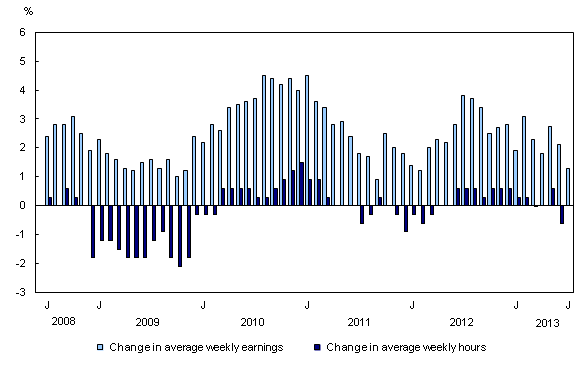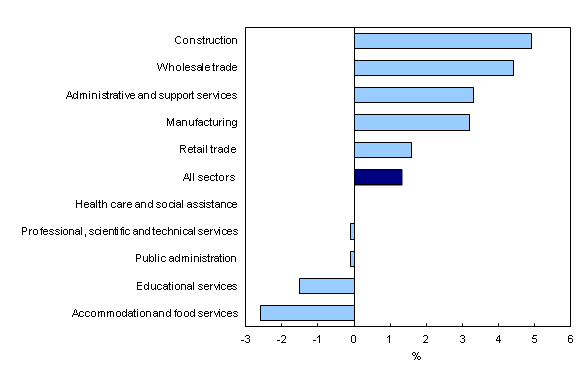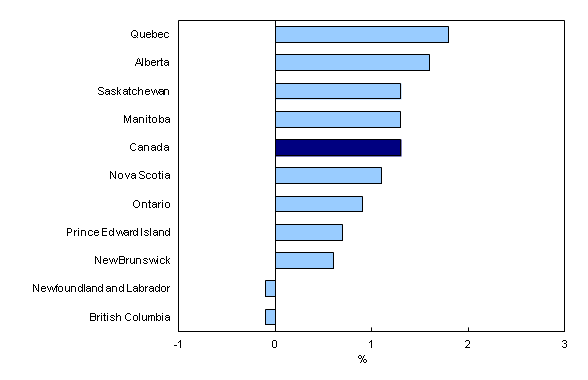Payroll employment, earnings and hours, July 2013
Archived Content
Information identified as archived is provided for reference, research or recordkeeping purposes. It is not subject to the Government of Canada Web Standards and has not been altered or updated since it was archived. Please "contact us" to request a format other than those available.
Released: 2013-09-27
Average weekly earnings of non-farm payroll employees were $914 in July, virtually unchanged from the previous month. On a year-over-year basis, earnings increased 1.3%.
The 1.3% increase in weekly earnings during the 12 months to July reflected a number of factors, including wage growth, changes in composition of employment by industry, occupation and level of job experience, as well as average hours worked per week. Non-farm payroll employees worked an average of 33.0 hours per week in July, compared with 32.9 hours in June. On a year-over-year basis, the average hours worked was unchanged.
Average weekly earnings by sector
Year-over-year growth in average weekly earnings outpaced the national average in five of the largest industrial sectors, led by construction and wholesale trade.
Compared with 12 months earlier, average weekly earnings in construction increased 4.9% to $1,192 in July, led by gains in heavy and civil engineering construction.
In the 12 months to July, weekly earnings in wholesale trade rose by 4.4% to $1,084, with all of the gains taking place from October 2012 to February 2013. Among the larger industries in this sector, earnings for merchant wholesalers of food have been on an upward trend throughout the 12-month period, while earnings in machinery, equipment and supplies have been increasing since March 2013.
Average weekly earnings grew by 3.3% in administrative and support services to $759. Several industries posted earnings increases over the 12 months to July, including employment services; other support services, as well as business support services.
Compared with 12 months earlier, weekly earnings in manufacturing rose by 3.2% to $1,036, with all the gains since March 2013. Over the 12-month period, growth was highest in the manufacturing of chemical products; furniture and related products; computer and electronic products; and plastics and rubber products.
Weekly earnings in retail trade increased 1.6% to $537, as growth in seven retail trade industries were partly offset by declines in five others.
Average weekly earnings in educational services declined by 1.5% to $1,000, with the decreases concentrated mainly in elementary and secondary schools (see Note to readers).
From a high of $374 in July 2012, average weekly earnings in accommodation and food services declined by 2.6% to $364 in July. Declines were mainly in the two largest industries in this sector, traveller accommodation; and full-service restaurants and limited-service eating places.
Average weekly earnings by province
Year-over-year earnings of non-farm payroll employees grew in eight provinces, and the growth was above the national average in Quebec and Alberta. At the same time, earnings in Newfoundland and Labrador and British Columbia were little changed.
Average weekly earnings in Quebec rose 1.8% to $836, with gains spread across many industries.
In Alberta, average weekly earnings increased 1.6% to $1,098 in the 12 months to July, with growth in most sectors.
In Newfoundland and Labrador, average weekly earnings were $934, little changed from 12 months earlier. Earnings in this province have been edging down since peaking in February at $953.
Earnings in British Columbia were $870 in July and have been relatively flat since July 2012.
Non-farm payroll employment by sector
Total non-farm payroll employment increased by 60,300 in July, following a decline of 8,900 in June. In the 12 months to July, the number of non-farm payroll employees rose by 94,400 or 0.6%. Employment was relatively flat from August 2012 to June 2013.
In July, the number of payroll employees increased in many sectors. The largest gain was in construction, primarily because of a rebound from a construction job decline in Quebec in June. There were also employment gains in health care and social assistance; accommodation and food services, as well as administrative and support services. At the same time, there were decreases in retail trade and manufacturing.
Among all sectors, real estate and rental and leasing posted the highest 12-month growth rate in payroll employment at 4.8%, with most of the gains occurring since December 2012. Employment growth rates from July 2012 to July 2013 were also notable in accommodation and food services (+3.4%), a sector that has been on an upward trend since early 2011.
Since July 2012, there have been notable job declines in two sectors. Payroll employment fell 2.4% in information and culture, with the losses spread across a number of industries within the sector. The other sector was manufacturing, where employment decreased 1.2%, with the declines occurring since March 2013.
Note to readers
The Survey of Employment, Payrolls and Hours (SEPH) is produced by a combination of a census of payroll deductions, provided by the Canada Revenue Agency, and the Business Payrolls Survey, which collects data from a sample of 15,000 establishments. Its key objective is to provide a monthly portrait of the level of earnings, the number of jobs and hours worked by detailed industry at the national, provincial and territorial level.
Estimates of average weekly earnings and hours are based on a sample and are therefore subject to sampling variability. Payroll employment estimates are based on a census of administrative data and are not subject to sampling variability.
Statistics Canada also produces employment estimates from its monthly Labour Force Survey (LFS). The LFS is a household survey, the main objective of which is to divide the working-age population into three mutually exclusive groups: the employed (including the self-employed), unemployed and not in the labour force. This survey is the official source for the unemployment rate and collects data on the socio-demographic characteristics of all those in the labour market.
As a result of conceptual and methodological differences, estimates of changes from SEPH and LFS do differ from time to time. However, the trends in the data are quite similar.
Unless otherwise stated, this release presents seasonally adjusted data, which facilitates comparisons by removing the effects of seasonal variations. For more information on seasonal adjustment, see Seasonal adjustment and identifying economic trends.
Non-farm payroll employment data are for all hourly and salaried employees, as well as the "other employees" category, which includes piece-rate and commission-only employees.
Average weekly hours data are for hourly and salaried employees only and exclude businesses that could not be classified to a North American Industry Classification System (NAICS) code.
All earnings data include overtime pay and exclude businesses that could not be classified to a NAICS code. Earnings data are based on gross taxable payroll before source deductions. Average weekly earnings are derived by dividing total weekly earnings by the number of employees.
With each release, data for the current reference month are subject to revision. Data have been revised for the previous month. Users are encouraged to request and use the most up-to-date data for each month.
Data on the education sector
Changes in payroll employment in education during the summer months can be affected by changes in payment schedules and school-year calendars. Month-to-month and year-over-year movements should therefore be interpreted with caution, and more attention given to long-term trends.
A data table is available from the Browse by key resource module of our website under Summary tables.
Data on payroll employment, earnings and hours for August will be released on October 31.
Contact information
For more information, or to enquire about the concepts, methods or data quality of this release, contact us (toll-free 1-800-263-1136; 514-283-8300; infostats@statcan.gc.ca).
To enquire about the concepts, methods or data quality of this release, contact Emmanuelle Bourbeau (613-951-3007; emmanuelle.bourbeau@statcan.gc.ca), Labour Statistics Division.
- Date modified:




